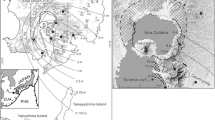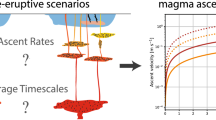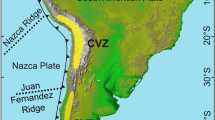3
of magma erupted, ∼95% of which was deposited as fall layers. During most of the deposition of P1, eruptive intensity (mass flux) was almost constant at 4–8×107 kg s−1, producing a Plinian column 25–30 km in height. Size grading at the top of P1 indicates, however, that mass flux waned dramatically, and possibly that there was a brief pause in the eruption. During the post-P1 phase of the eruption, a much smaller volume of magma erupted, although mass flux varied by more than an order of magnitude. We suggest that caldera collapse began at the end of the P1 phase of the eruption, because along with the large differences in mass flux behavior between P1 and post-P1 layers, there were also dramatic changes in lithic content (P1 contains ∼8% lithics; post-P1 layers contain 30–60%) and magma composition (P1 is 98% rhyodacite; post-P1 layers are 60–90% rhyodacite). However, the total volume of magma erupted during the Jala pumice event is close to that estimated for the caldera. These observations appear to conflict with models which envision that, after an eruption is initiated by overpressure in the magma chamber, caldera collapse begins when the reservoir becomes underpressurized as a result of the removal of magma. The conflict arises because firstly, the P1 layer makes up too large a proportion (∼75%) of the total volume erupted to correspond to an overpressurized phase, and secondly, the caldera volume exceeds the post-P1 volume of magma by at least a factor of three. The mismatches between model and observations could be reconciled if collapse began near the beginning of the eruption, but no record of such early collapse is evident in the tephra sequence. The apparent inability to place the Jala pumice eruptive sequence into existing models of caldera collapse, which were constructed to explain the formation of calderas much greater in volume than that at Ceboruco, may indicate that differences in caldera mechanics exist that depend on size or that a more general model for caldera formation is needed.
Similar content being viewed by others
Author information
Authors and Affiliations
Additional information
Received: 18 November 1998 / Accepted: 23 October 1999
Rights and permissions
About this article
Cite this article
Gardner, J., Tait, S. The caldera-forming eruption of Volcán Ceboruco, Mexico. Bull Volcanol 62, 20–33 (2000). https://doi.org/10.1007/s004450050288
Issue Date:
DOI: https://doi.org/10.1007/s004450050288




